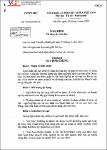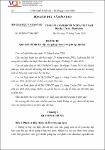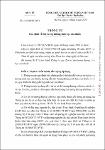Tìm kiếm
Tác giả
- Nguyễn, Trường Sơn (8)
- Adler, Richard M. (1)
- Bộ Giáo dục đào tạo (1)
- Chính phủ (1)
- Sau >
Chủ đề
- chuẩn đoán (4)
- điều trị (4)
- hướng dẫn (3)
- quyết định (2)
- Sau >
Năm xuất bản
Toàn văn
- true (22)
Kết quả tìm kiếm
Số/Ký hiệu 72/2020/QH14
Ngày ban hành 17/11/2020
Ngày có hiệu lực 01/01/2022
Người ký Nguyễn Thị Kim Ngân
Trích yếu Luật Bảo vệ môi trường
Cơ quan ban hành Quốc hội
Phân loại Luật |
Thông tư số 20/2020/TT-BGDĐT – Quy định chế độ làm việc của giảng viên cơ sở giáo dục đại học |
Its chapters provide a historical perspective and general understanding of the legal settings of Turkish Environmental Law; offer an overall understanding of the evolving and prevailing paradigms of legislation and administrative practices in environmental policy in Turkey; explain how EIA has become the main environmental management tool and instrument of environmental compliance in Turkey; discuss the project process, challenges and results of the EU-funded project ‘Turkey’s Map of Environmental Violations’ and food security in Turkey; and present a picture of environmental justice movements from bottom-up over the establishment and operation of small-scale hydroelectricity power plants. |
This title provides managers, executives and other professionals with an innovative method for critical decision-making. The book explains the reasons for decision failures using the Law of Unintended Consequences. This account draws on the work of sociologist Robert K. Merton, psychologists Amos Tversky and Daniel Kahneman, and economist Herbert Simon to identify two primary causes: cognitive biases and bounded rationality. It introduces an innovative method for “test driving” decisions that addresses both causes by combining scenario planning and “what-if” simulations. This method enables professionals to learn safely from virtual mistakes rather than real ones. It also provides four sample test drives of realistic critical decisions as well as two instructional videos to illustr... |
Ban hành kèm theo Quyết định này Hướng dẫn giám sát phản ứng có hại của thuốc (ADR) tại các cơ sở khám bệnh, chữa bệnh. |
Ban hành kèm theo Quyết định này tài liệu “Hướng dẫn thực hiện quản lý sử dụng kháng sinh trong bệnh viện”. |
Ban hành kèm theo Quyết định này Mẫu phiếu phân tích sử dụng thuốc và bộ mã liên quan, gồm:
1. Phụ lục 1. Mẫu Phiếu phân tích sử dụng thuốc.
2. Phụ lục 2. Bộ mã các vấn đề liên quan đến thuốc và can thiệp của người làm công tác dược lâm sàng. |
Điều 1. Phạm vi điều chỉnh, đối tượng áp dụng
Điều 2. Hồ sơ đánh giá cơ sở đủ điều kiện thử tương đương sinh học
của thuốc
Điều 3. Quy trình, thủ tục đánh giá cơ sở đủ điều kiện thử tương đương
sinh học của thuốc
Điều 4. Xử lý kết quả đánh giá cơ sở đủ điều kiện thử tương đương sinh
học của thuốc
Điều 5. Đánh giá việc duy trì đáp ứng điều kiện đối với cơ sở thử tương
đương sinh học của thuốc.
Điều 6. Hướng dẫn thử tương đương sinh học của thuốc
Điều 7. Hồ sơ thử tương đương sinh học của thuốc
Điều 8. Quy trình thử tương đương sinh học của thuốc
Điều 9. Sửa đổi, bổ sung Phụ lục I Thông tư số 29/2018/TT-BYT
Điều 10. Hiệu lực thi hành
Điều 11. Điều khoản tham chiếu
Điều 12. Trách nhiệm thi hành |








